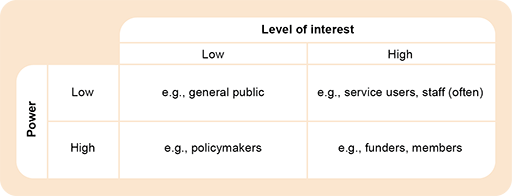2.1 Understanding power
A method used to depict the relationship between a stakeholder’s interest in the organisation and the power they have to influence it is a matrix (see Figure 4). On this matrix, large-scale funders, for example, would be placed in the high interest/high power category. Similarly, an organisation might have stakeholders that have a high degree of power but little interest in the success of the organisation (for example policy makers). This might apply to some of the secondary stakeholders you identified in Activity 2. What about those with a high degree of interest but low power? Service users and staff in the organisation will often fall within this category, but not always.
Activity 4 Power in practice
Create your own version of Figure 4 and use it to allocate the different stakeholders from the organisation you chose in Activity 2 to the different parts of the matrix.
Comment
This type of stakeholder mapping can be used for thinking about how organisations engage with their stakeholders. Allocating different groups within the matrix helps organisations to think about who has power and who should have more. Empowering groups, particularly service users and beneficiaries, is discussed in Week 6.

